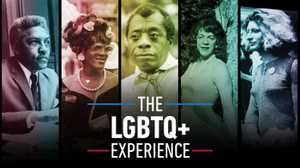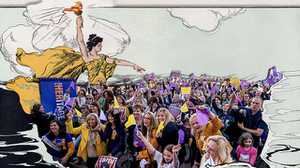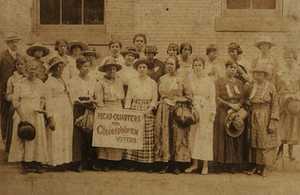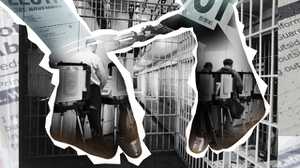
She was always called Mrs. Catt, a title of respect worthy of a suffrage leader who served as president of the National American Woman Suffrage Association from 1900-1904 and then again from 1915-1920. Her loyal followers were familiar with her life story: born Carrie Clinton Lane in Ripon, Wisconsin but raised in Iowa, she was an early graduate of Iowa State University (1880) who worked as a school principal and superintendent before marrying newspaper editor Leo Chapman in 1885. Just one year into their marriage, he died of typhoid fever. In 1890 she married George Catt, a wealthy engineer. Neither marriage produced children.
The Catts had quite an unusual marriage for the time: they often did not live together, while she, with his blessing, continued the suffrage work that kept her constantly on the road. Around the same time as her second marriage, Catt met Mary (Mollie) Garrett Hay, a fellow Midwesterner whose temperance activism with the Women’s Christian Temperance Union led her to the suffrage movement. The two women often campaigned together, and in 1895, they shared temporary living arrangements in New York. In 1899 the two women traveled 13,000 miles, giving 51 speeches in 20 states.
After George Catt’s death in 1905, Carrie and Mollie chose to live together permanently, functioning as something of a power couple in New York State suffrage circles. Catt divided her energies between the state and national movement while Hay headed up the New York Equal Suffrage League and the Woman Suffrage Party of New York City. Both women played especially prominent roles in the 1915 and 1917 campaigns for a New York State women’s suffrage referendum. Hay had a reputation for being difficult to work with, but she was Catt’s closest political confidante until her death in 1928.
When Carrie Chapman Catt died in 1947, she chose to be buried not with either of her husbands but beside Mollie Hay at Woodlawn Cemetery in the Bronx, where she erected this monument: “Here lie two, united in friendship for thirty-eight years through constant service to a great cause.” Catt chose the word “friendship” to describe her relationship with Hay, but historians point to the couple as a prime example of how the suffrage movement provided a safe and welcoming space for a variety of unconventional lifestyles, all hiding in plain sight. It isn’t simply a case of who’s gay and who’s not: after all, Catt had relationships with both men and women. To speak of “queering the suffrage movement” is to identify it as a place where women felt free to express a wide range of gender non-conforming behaviors, including but not limited to sexual expression, in both public and private settings.

Anna Howard Shaw also flouted conventional heteronormativity while rising to a position of national leadership in the suffrage movement. Like Carrie Chapman Catt, Shaw, who served as NAWSA’s president from 1904 to 1915, was an ambitious woman who challenged traditional gender norms. Born in England, she emigrated with her family to Massachusetts in 1851 and, from there, on to the frontier of Michigan. Determined to make her way in the world, after college Shaw attended Boston University Theological School and was ordained as a Methodist minister in 1880. She also received a medical degree from Boston University in 1886. But her true gift was as an orator and lecturer, especially for women’s suffrage.
Anna Howard Shaw became part of Susan B. Anthony’s extended family when she began a long term relationship with Anthony’s niece Lucy. Shaw made a special point of telling the revered suffrage leader that she would provide for Lucy for the rest of her life, and she kept that promise. The two women merged their finances (Lucy acted as Anna’s business manager, for which she was paid a salary) and basically functioned like a married couple. When Shaw died in 1919, her ashes were scattered on the grounds of Alnick Lodge, the home outside Philadelphia she and Lucy built in 1905.
Susan B. Anthony herself led a decidedly queer life. “Man-marriage” held no appeal, so she sustained her emotional life with deep friendships with other women, often suffrage-linked. Her most passionate was with the twenty-four-year-old Anna Dickinson, whom Anthony met in 1866 when she was forty-six. But that cooled after a few years and the peripatetic Anthony never settled into a long-term relationship with any one woman. Instead “Aunt Susan” surrounded herself with a range of fictive suffrage nieces, most notably Rachel Foster (later Avery) but also including Carrie Chapman Catt and Anna Howard Shaw. Labeling Susan B. Anthony queer acknowledges the range and depth of emotional attachments with which she constructed her non-normative personal life.
The lives of movement leaders tend to be better documented than those of the rank and file, but there is plenty of scattered evidence that nonheteronormative behavior was not confined to elite white suffragists. If you were involved in the suffrage movement, chances are you knew another suffragist who was part of a same-sex relationship or would now be considered queer.

Washington, D.C.’s vibrant African American community supported a range of alternative lifestyles, including the longstanding partnership between Lucy Diggs Slowe, the first Dean of Women at Howard University, and Mary Burrill, who had previously formed a romantic connection with Angelina Weld Grimke, another playwright and suffragist. Alice Dunbar-Nelson, an African American writer and organizer for the National Woman’s Party, had a range of relationships with both men and women. In California Margaret Jessie Chung, a pioneering Chinese-American physician, dressed in men’s clothing, had close relationships with women, and was called Mike by her friends. White working-class suffragists such as Pauline Newman and Rose Schneiderman shared their lives with other activist women in New York.
Turn-of-the-century American society and culture offered something of a golden age for such female friendships. In fact the social phenomenon of two women living together in a long-term relationship was so familiar that the term Boston Marriage was coined to describe it. Such a relationship with a “companion” or a “friend” offered women a socially accepted alternative to the traditional routes of marriage and children or what was seen as lonely spinsterhood; family and friends, let alone the public, rarely suspected that two women living together might actually share a sexual attraction. The exact emotional dimensions of these romantic friendships have often been lost to history, but they were life-affirming for those who formed them.
Only in the 1920s did the work of sexologists such as Freud, Krafft-Ebbing and Havelock Ellis begin to alter the American understanding of the role of sexuality in modern life. At that time, being normal increasingly began to mean being actively heterosexual. Along with these new medical concepts came a tendency to reinterpret women’s feelings for other women in a decidedly negative light: love between women became identified as perverse, distorted and unnatural.
While these new attitudes would shift the terrain of same-sex relationships after the 1920s, or at least force them to be viewed in more explicitly sexual terms, such disapproval was less prevalent in an earlier time, which is precisely the heyday of the women’s suffrage movement. This tolerance had its limits, however. From the beginning the suffrage movement struggled with an undercurrent of accusations that it was engaged in a “sex war” with men which threatened the foundations of home and society. One of the easiest ways for opponents to ridicule suffragists was to call them “mannish” and draw attention to their unwillingness to abide by traditional gender norms of dress or behavior.
In response the suffrage leadership took steps to present itself as being led by respectable (what we might call now cisgender) women who conformed to traditional feminine norms of appearance and behavior. But those dodges don't erase the fact that many suffragists, both national leaders and those from the rank-and-file, lived decidedly queer lives in full view of the American public.

This begs the question of whether gender nonconforming women were drawn to suffrage activism because they were already queer: having embraced nontraditional choices for their personal lives, did that make them more interested and sympathetic to demanding changes in their political status as well? Perhaps. Single self-supporting women intuitively recognized one of the key tenets of suffrage ideology: there would be no man to protect or take care of them, and they would have to do it themselves. Maybe that made them more likely to demand the vote. Still it is impossible to know for sure whether there were more same-sex relationships in the suffrage movement than in the general population at the time.
The centennial of the Nineteenth Amendment has renewed interest in the history of women’s suffrage. Uncovering stories of lesser-known suffragists, especially African American women, provides a picture of a broader, more diverse movement waiting to be told. Uncovering and documenting the contributions of queer women to suffrage history is an important part of this legacy. The terms we use today did not yet exist, but LGBTQ+ people did, and the deeper we dig, the more queer women we are likely to find. In the case of suffrage history, however, there is no better place to start than at the top.

Susan Ware is the author and editor of numerous books on twentieth-century U.S. history, women's history, and biography. In addition to serving as the General Editor of American National Biography, she is currently the Honorary Women’s Suffrage Centennial Historian at the Schlesinger Library on the History of Women in America at the Radcliffe Institute for Advanced Study, Harvard University. She is the author of Why They Marched: Untold Stories of the Women Who Fought for the Right to Vote (2019) and the editor of the Library of America anthology American Women’s Suffrage: Voices from the Long Struggle for the Vote, 1776-1965 (2020). She also served as a historical consultant to the American Experiencedocumentary “The Vote".

Explore our new collection featuring a selection of films documenting the LGBTQ+ Experience — along with articles, digital shorts, and original features exploring America’s continued struggle with democracy, inclusion and justice for LGBTQ+ Americans, and celebrating the contributions of the LGBTQ+ community to the American story.







